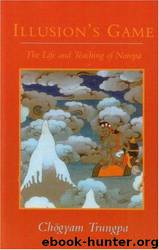Illusion's Game: The Life and Teaching of Naropa by Chogyam Trungpa

Author:Chogyam Trungpa
Language: eng
Format: azw3, epub
ISBN: 9780877738572
Publisher: Shambhala
Published: 1994-06-28T00:00:00+00:00
THREE
Choiceless Awareness
PRAJNA SEEMS TO BE a way of opening many gates. Through prajna one discovers the real meaning of shunyata. Discovering shunyata is very powerful, and it is also frightening. Prajna could be described as a way of opening up the shunyata experience—that is, a way of being cornered. You get cornered into “this” to the extent that finally you have to escape through the walls. That is, you have to see the walls as empty; otherwise, you cannot escape.
Shunyata is more of a meditative experience than intellect is. It is often referred to as choiceless awareness—you do not develop an understanding of shunyata, but rather it comes to you. When a person has developed his intellect—clarity and sharpness—to a certain level, that provides a kind of ground that makes it possible for him to see the nonexistence of shunyata—and the fullness of shunyata at the same time.
You might say, “But what’s left after prajna has done its cutting through?” There is lots left. The process of cutting through also has to be exposed, to the point where the journey no longer exists, the process doesn’t exist anymore, the effort doesn’t exist anymore. Shunyata is truly choiceless and does not compromise. Once you realize that you have no ground at all, none whatsoever, you are suspended in midair. When you cry for help, nobody is around you, and your voice itself becomes shunyata, so you can’t even shout. Your actions to save yourself become nonexistent, which is the result of cutting through. Because you have cut through so much, finally your own ground has been cut through completely. Then the process of cutting through no longer exists. There is no occupation of any kind at all.
We should understand as a general principle the logic of subject and object and their duality, which I mentioned in the previous talk. Duality is not composed of two separate entities. Subject and object are not two different entities. They are one. By creating a wall within the one, we produce duality. Thus, shunyata is simply an expansion of “this.” That is why it is called choiceless awareness. “This” pushes the walls out; “this” expands.
You might ask, “If only ‘this’ exists, does that conflict with the general idea of egolessness?” Absolutely not. Ego and egolessness have nothing to do with “this.” Actually ego is based on “that”; failing to realize “this” is what created ego. So the more you realize “this” or “here,” the more groundless you become.
You don’t have to have ground, but as I mentioned already, at the beginning this is rather frightening. There was an analogous moment in Naropa’s life. He had been training for eight years in the monastery and had passed his oral examination, which took the form of logical debates, and he had become the head of Nalanda. At that point, he had a vision of an ugly woman, which was a shock, a sudden shock. According to traditional interpretations, this woman was Vajrayogini, who is a symbol of shunyata.
Download
Illusion's Game: The Life and Teaching of Naropa by Chogyam Trungpa.epub
This site does not store any files on its server. We only index and link to content provided by other sites. Please contact the content providers to delete copyright contents if any and email us, we'll remove relevant links or contents immediately.
Periodization Training for Sports by Tudor Bompa(8170)
Bodyweight Strength Training by Jay Cardiello(7841)
Born to Run: by Christopher McDougall(7065)
Inner Engineering: A Yogi's Guide to Joy by Sadhguru(6725)
Asking the Right Questions: A Guide to Critical Thinking by M. Neil Browne & Stuart M. Keeley(5635)
The Fat Loss Plan by Joe Wicks(4847)
Bodyweight Strength Training Anatomy by Bret Contreras(4612)
Yoga Anatomy by Kaminoff Leslie(4306)
Dynamic Alignment Through Imagery by Eric Franklin(4118)
Science and Development of Muscle Hypertrophy by Brad Schoenfeld(4089)
ACSM's Complete Guide to Fitness & Health by ACSM(3989)
Exercise Technique Manual for Resistance Training by National Strength & Conditioning Association(3956)
The Four-Pack Revolution by Chael Sonnen & Ryan Parsons(3932)
Bodyweight Strength Training: 12 Weeks to Build Muscle and Burn Fat by Jay Cardiello(3915)
The Ultimate Bodybuilding Cookbook by Kendall Lou Schmidt(3886)
Yoga Anatomy by Leslie Kaminoff & Amy Matthews(3863)
American Kingpin by Nick Bilton(3757)
Nutrition for Sport, Exercise, and Health by Spano Marie & Kruskall Laura & Thomas D. Travis(3715)
Yoga Therapy by Mark Stephens(3703)
